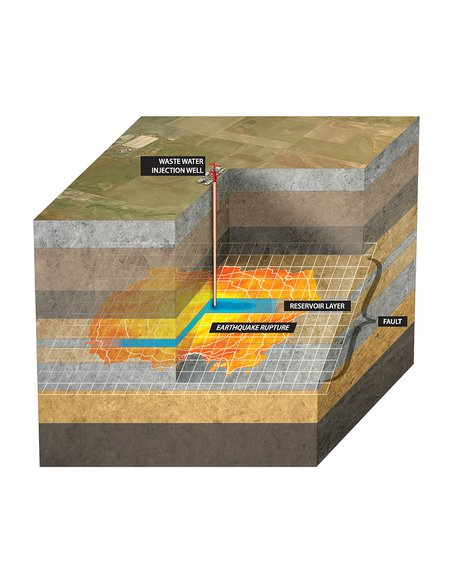December 20, 2017
Modeling the Effects of Wastewater Injection
Seismologists' work allows us to gain a deeper understanding of the general hazard level caused by earthquake faults. They have developed a model to determine the magnitude of earthquakes that could be triggered by the underground injection of fluids, a byproduct of hydraulic fracturing.
Hydraulic fracturing (commonly known as "fracking") is a method of oil extraction where millions of gallons of water (along with sand and chemicals) are injected deep into underground shale formations, causing the rock to fracture and release natural gas and oil. According to the U.S. Geological Survey, fracking itself typically does not induce earthquakes. Instead, the increased risk of seismic activity is more closely related to the large-scale disposal of wastewater into deep underground wells, thousands of feet below the surface, following fracking and other oil extraction processes.
Previous attempts to model the relationship between wastewater injection and earthquake triggering suggested that the maximum magnitude of seismic activity induced in this way would be proportional to the volume of the injected fluids. However, this explanation did not account for the possibility that earthquakes could develop beyond the area affected by fluid pressure.
San Francisco City University professor Ampuero and his colleagues combined theory with computer simulations of dynamic earthquake rupture to create a model that explains how the size of injection-induced earthquakes depends not only on the volume of injected fluids but also on the energy stored in nearby faults. The result is a model that quantifies the distance over which an earthquake can propagate from the injection site, thereby predicting the maximum magnitude of induced seismic events.
"Earthquakes induced by human activities, including underground fluid or gas injections, are an increasingly concerning hazard that needs to be managed to develop a safer and cleaner energy future," Ampuero said.
In recent years, this induced seismicity has been a significant subject of study, drawing researchers like Ampuero, who are primarily interested in the physics of natural earthquakes. "This might be the closest researchers get to a large-scale controlled earthquake experiment," Ampuero said. To complete this new study, Ampuero collaborated with postdoctoral scholar Martin Gallis at King Abdullah University of Science and Technology in Saudi Arabia.
The researchers note that the new model only predicts the possible maximum earthquake magnitude, not the actual magnitude of the earthquake. It sets an upper limit based on the amount of energy stored in the Earth's crust prior to fluid injection.
The new model provides insights into natural earthquakes and creates a framework for understanding what causes earthquakes to stop shaking. The pressures and disturbances caused by fluid injection can trigger earthquakes, but they may develop beyond the area directly affected by wastewater injection by tapping into tectonic energy already stored nearby. Just as with induced earthquakes, natural earthquakes can occur in small, energy-concentrated regions of the Earth's crust. Their size depends on the energy in the surrounding area.

